Abstract
The aim of the present study was to compare lactate removal during active recovery performed during cycling in water immersion (CW) and during cycling on land (CL), after a similar exercise bout in male adults. Eleven healthy and physically active men, aged between 20 and 26 years old participated in the experiment. Before the experimental tests, the ventilatory threshold of the subjects was determined. Each subject completed the experimental tests twice, with one week separating the two periods of experiment. The subjects exercised on the treadmill during 6 min at a speed 10% above the speed corresponding to their ventilatory threshold. Subsequently, the subjects recovered from the exercise bout either on a stationary bike (CL) or on a aquatic-specific bike (CW). On the subsequent week the subjects performed the same protocol but with a different recovery condition. Recovery condition assignment for the first test was counterbalanced (six subjects started with one condition and five with the other). Capillary blood samples were collected after each test and during the recovery period (at 3, 6, 9 and 15 minutes) and blood lactate was measured. The blood lactate values during CW were lower than during CL and significant differences were observed at the 6th minute (p ≤ 0.05) and at the 15th minute of recovery (p ≤ 0.05). Therefore, we may conclude that active recovery using cycling in water immersion may be more efficient than cycling on land for blood lactate removal.
Key points.
Previous studies have found positive effects of half liquid environment on blood lactate removal.
However, few studies have compared lactate removal in half liquid and in dry land conditions with the use of stationary bikes.
We have compared the lactate removal during active recovery on half-liquid cycling and active recovery on dry land cycling after a similar exercise bout in male adults.
The blood lactate values during the recovery were lower after half-liquid cycling when compared with dry land cycling and significant differences were observed at the 6th minute and at the 15th minute of recovery.
We may conclude that active recovery using half-liquid cycling may be more efficient than dry land cycling for blood lactate removal.
Key words: Active recovery, water exercise, land exercise
Introduction
Lactate is an important metabolite in the re synthesis of ATP, and its removal may be a way to regain energy substratum (Robergs et al., 2004). Therefore, lactate oxidation may contribute to save muscle carbohydrate stores and help to sustain exercise intensity during long time exhaustive exercise (Brooks, 1986). The removal of lactate after exercise can be performed in active or passive recovery. The literature describes a faster lactate removal when using active compared with passive recovery (Baker and King, 1991; Bonen and Belcastro, 1976; Franchini et al., 2003; Monedero and Donne, 2000; Taoutaou et al., 1996). Moreover, it has been shown that different exercise intensities may have different effects on blood lactate removal (Baldari et al., 2004; 2005). Most of the research has focused on the benefits of dry land exercise on lactate removal (Boileau et al., 1983; Gupta et al., 1996; Koutedakis and Sharp, 1985; Monedero and Donne, 2000; Taoutaou et al., 1996). Nakamura et al., 1996 investigated the effect of water immersion in blood lactate removal after a high-intensity (80% of peak VO2) single bout of exercise. They have found that immersion in water with a temperature of 30°C promoted a better lactate removal, when compared with immersion at 39°C or with controls (no water immersion). The exercise in water immersion (or half immersion) may offer differentiated physiological conditions during and after exercise and alter cardiovascular (Ertl et al., 1991; Park et al., 1999) and respiratory functions (Brechat et al., 1999; Chu et al., 2007).
Previous studies compared the removal of blood lactate during land jogging or running and during immersed running (Nakanishi et al., 1999; Town and Bradley, 1991; Villar and Denadai, 1998). Nakanishi et al., 1999 investigated and compared physiological responses of healthy men performing an exhaustive exercise bout either in deep water running (DWR) or treadmill running. The heart rate during the exercise bout and the peak blood lactate post exercise were higher in the dry land running. Town and Bradley, 1991 compared the metabolic responses to a single bout of maximum exertion in three conditions of exercise: deep water running (DWR), shallow water running and running in the treadmill. They have found that blood lactate values from shallow water and DWR were 80% of the response in the treadmill. Villar and Denadai, 1998 compared active recovery during land running with active recovery during DWR. In each of the exercise conditions the intensity of the recovery was established as the heart rate corresponding to the aerobic threshold (previously assessed either in dry land or DWR environments). The results have shown that during land running lactate removal was larger than during the DWR recovery. Frangolias and Rhodes, 1995 also compared the lactate removal after treadmill running and running in immersion and found no differences between the two exercise conditions. However, none of the abovementioned studies have compared lactate removal between water immersed and dry land conditions with the use of stationary bikes.
Connelly et al., 1990 used cycling exercise to investigate the effects of water immersion, but their analysis was limited to the responses during exercise and not post-exercise. These authors found that the accumulation of blood lactate during cycling exercise at intensities comprised between 40% and 80% of the peak oxygen uptake was not different when water immersion or land exercise were compared, but higher percentages resulted in lower blood lactate values for water immersion.
Therefore, the aim of the present study was to compare lactate removal during active recovery performed during cycling in water immersion (CW) and during cycling on land (CL) after a similar exercise bout in male adults.
Methods
Participants
Eleven males volunteered for this study. After a medical examination the subjects gave their written informed consent to participate in the experiments. The subjects were healthy and were engaged in regular physical activity for at least six months prior to testing. The subjects mean (± standard deviation) age, height, weight and estimated body fat percentage were 22.7 ± 1.9 years, 1.80 ± 0.02 m, 79.9 ± 2.9 kg and 10.6 ± 1.2 %, respectively. All the procedures were according to the Helsinki Declaration of 1975 and were approved by the Institutional Ethics Committee.
Procedures
The subjects were assessed on three occasions and they reported in the laboratory after an overnight fast. On their first visit to the laboratory the subjects were measured for height, weight and skin folds. Body fat was estimated from three skin fold thickness (Jackson and Pollock, 1978) measured with a Lange skin fold caliper (Beta Technology, Santa Cruz CA, USA) and on the same day, the ventilatory threshold of the subjects was determined with the Ellestad protocol (Ellestad, 1993) on a motorized treadmill (XT600Pro, TecnhoGym, Italy). Since this protocol was originally designed for cardiopulmonary patients, in the present study the subjects started the protocol in the second stage (2 min at 1.33 m·s-1 with 10% grade) and followed the rest of the original protocol. Through all testing expired gases were collected and analysed with a VO2000 analyser (AeroSport Inc, USA) and oxygen uptake was averaged as 20 s intervals. Before each test, a reference air calibration of the device was performed using a gas sample with a 16% O2 concentration and a 5% CO2 concentration. The flow meter was also calibrated before each testing with a 3000 ml syringe. The Ventilatory Threshold (VT) was assessed from respiratory exchange by three observers using the V-slope method (Beaver et al., 1986). The mean of the two closest values was taken into account for calculating the VT.
In the second and third testing sessions, each subject completed the testing protocol under the two recovery conditions. One week separated each of the three sessions. The testing protocol included a running warm-up of 2 min at 5.5 km·h-1 with a 10% treadmill grade. After the warm-up the subjects exercised on the treadmill during 6 min at a speed 10% above the speed corresponding to their ventilatory threshold previously assessed. Subsequently, the subjects started the 15 min active recovery either on a regular stationary bike (Schwinn, USA) or on a water-specific bike (Hydroraider, Italy). Recovery condition assignment for the first test was counterbalanced (six subjects started with one condition and five with the other). The time interval between the end of the exercise bout and the start of the active recovery period was 1 min. The aquatic bike was placed in a pool in a way that the xyphoid appendix of each subject matched the water level. Heart rate (HR) was assessed throughout the recovery periods with a Polar S810 (Polar, Finland) and used to assure the similar exercise intensity under the two conditions of exercise. The target HR was established as 65% of the estimated maximum HR (220 beats per minute minus age). During the recovery period the subjects were informed about their HR every 30 sec and the pace was adjusted if necessary. Capillary blood samples were collected at rest and during the recovery period (at 3, 6, 9 and 15 minutes of recovery) for blood lactate measurement with a YSI 1500 analyser (Yellowsprings, OH, USA). Prior to each testing, the analyser was calibrated with standard lactate solutions of 2. 5, 5.0, 10.0 and 15.0 mmol·L-1 (Yellowsprings, OH, USA).
Both the laboratory and the pool sessions were conducted with a room temperature between 22°C and 24°C and ≈50% of relative humidity. The temperature of the pool water was between 30 and 31°C.
Statistical analyses
Data was analysed with SPSS 10.0 (SPSS Science, Chicago, USA) and the graphics were designed with Sigma Plot 8.0 (SPSS Science, Chicago, USA). The results are presented as means ± standard deviations (SD). Mean differences between the two conditions of recovery were tested by the Wilcoxon Matched-Pairs Rank test, as the distribution of the sample failed to comply with the normality assumption. The statistical significance was set to p ≤ 0.05.
Results
The resting blood lactate concentration before the experimental periods of treadmill exercise was similar (p = 0.645) under the two exercise conditions (1.64 ± 0.05 and 1.60 ± 0.08 mmol·L-1, respectively for cycling on land and cycling in water immersion).
The mean values of blood lactate were lower during the active recovery performed in water immersion cycling compared to the values observed in land cycling. Significant differences were found in the 6th min (p = 0.011) and 15th min (p = 0.014), but not in the 3rd min (p = 0.210) nor on the 9th min (p = 0.052) post-exercise (see Figure 1).
Figure 1.
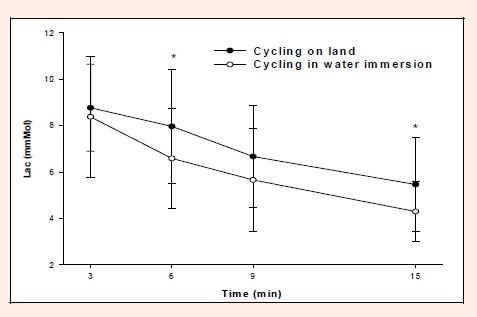
Comparison of the blood lactate removal during cycling in water immersion (CW) and during cycling on land (CL).
* Difference between CW and CL (p ≤ 0.05).
Discussion
The aim of the present study was to compare lactate removal during active recovery performed during cycling in water immersion (CW) and during cycling on land (CL) after a similar exercise bout in male adults. We hypothesized that CW could be more effective when compared with CL.
In the present study, differences between the blood lactate removal under the two conditions of exercise were found to be significant in the 6th min and 15th min, but not in the 9th min post-exercise. The small size of the sample that was used may contribute to the lack of significance observed at the 9th min of recovery. Therefore, the results indicate that a low intensity recovery at 65% HRmax was more effective when performed in immersion. The faster lactate removal during immersion exercise condition may be partly explained by an increased venous return. At the 3rd min of recovery the blood lactate mean values were close in CW and CL, which may help to support that the blood lactate accumulation during the previous exercise bouts was similar under the two conditions of exercise and that three min of recovery were not sufficient to improve the lactate removal during CW.
The exercise intensity in the present study was comprised within the range studied by Connelly et al., 1990 when they found no significant differences in blood lactate accumulation between water immersed and land cycling exercise. However, those authors examined blood lactate accumulation during the cycle exercise and not the lactate removal post-exercise. The mechanisms underlying blood lactate accumulation during exercise are not necessarily the same as those determining lactate removals after exercise. During exercise, several factors affect the lactate concentration found in muscle (and reflected in blood), some of them influencing the lactate production and others the lactate clearance. When exercise stops, even when a low intensity recovery exercise is used, only the factors that influence the lactate removal are pertinent. Therefore, the results from Connelly et al., 1990 are not comparable to the results that were found in the present study.
The lower lactate accumulation reported for DWR by Nakanishi et al., 1999 were explained by differences in muscle contraction regimens and by the influence of hydrostatic pressure of the water. However, the Nakanishi study and Town and Bradley’s (1991) lower blood lactate values in immersed compared with land running could be explained by a lesser muscle fiber constriction with immersion and by the weight bearing nature of treadmill running. These studies suggest a lower metabolic demand during running in water immersion.
Nakamura et al., 1996 and Villar and Denadai, 1998 support the present study with lower recovery lactates during immersed passive and active recovery, respectively. Contrarily, Frangolias and Rhodes, 1995 found no differences between the lactate removal after treadmill running and running in immersion.
This conflict of results may be explained by differences in the methods that were used on the above mentioned studies and in the present study. Indeed, several issues may have influenced the results, such as: i) intensity of the recovery that was used (Boileau et al., 1983); ii) main muscle groups that were elicited (Bulbulian et al., 1987; Nakanishi et al., 1999); iii) temperature of the water (Moore et al., 1970; Nakanishi et al., 1999); iv) gradient of immersion (Moore et al., 1970); v) timing for capillary blood collections (Brooks, 1986); and vi) ingestion of nutrients prior to the experiment (Robergs et al., 2004).
The majority of the above-mentioned studies assessed running in immersion instead of cycling exercise. The amount of muscle mass involved in running is larger compared to the one that is used during cycling exercise. The larger muscle mass involved in running may induce a higher lactate accumulation during exercise. On the other hand, the larger active muscle mass may allow an increased lactate oxidation by muscle tissue during an active recovery. Additionally, it is also possible that during land running exercise, a fraction of the muscle mass that is active (i.e. upper limbs) may contribute to lactate oxidation rather than to lactate production, due to the non-propulsive nature of these muscles. Contrarily, during DWR it is possible that the upper limbs may assist in buoying up the subject by circular movements (Nakanishi et al., 1999). Moreover, during DWR the legs also tend to move differently from land running, because of the lack of firm footage and with a slower stride rate. Therefore, it is complex to explain the results of studies that addressed the land running vs DWR issue, let alone to compare those results with those obtained with cycling exercise. During cycling the phenomena determining lactate production and removal may be different. Indeed, both during land or immersion cycling, a much smaller muscle mass is active, other than the muscle used to produce work (compared to running exercise). Therefore, the blood lactate kinetics during and post running exercise may not be comparable with cycling exercise. Even when cycle exercise is compared between water immersion and land conditions, Chen et al., 1996 recommend the use of a single ergometer adapted for land and liquid environment. The authors indicate that this procedure aims to avoid the interference of different body posture in the physiological responses.
A possible limitation of the present study is the use of heart rate as criteria to establish similar exercise intensity in land and immersion cycling exercise. Indeed, it is difficult to impose the same exercise intensity in water immersion and in land, because at the same cycle ergometer output the oxygen uptake is higher in water immersion, due to drag effect of displacing water during limb movements (Brechat et al., 1999). We chose to use heart rate to monitor exercise intensity during the recovery because it may be an interesting option for coaches and it can be easily measured. It has also been described that the blood shift and water temperature during immersed exercise may have an effect on heart rate and cardiac output so that exercising at the same work load elicits a higher heart rate (Park et al., 1999). If this is true, then exercise intensity in the present study could have been lower during immersion when compared with land exercise. However, even if the exercise intensity during immersion was lower, this fact is not necessarily an explanation for the larger lactate removal that was observed. Nevertheless, the results of the present study must be viewed as preliminary and warrant further research using other criteria to establish the exercise intensity.
Conclusion
In summary, the main finding of the present study was that blood lactate removal after an exercise bout with intensity above the ventilatory threshold, was more effective when performed during cycling in water immersion when compared with cycling on land. These results indicate that cycling in water immersion may be an effective way for sportsmen to recover between consecutive training sessions and even between exercise bouts within the same training session. Deep-water running (DWR) is more popular then immersion cycling. However, DWR is often uncomfortable, even to experienced runners. Therefore, we believe that immersion cycling may be a more comfortable and attractive recovery condition. Further studies are warranted to confirm the benefits of immersion cycling in blood lactate removal, mainly those analyzing the recovery after high-intensity running exercises.
Biographies
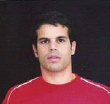
Fabrízio Di Masi
Employment
Ass. Prof. at the Physical Education Course of Federal Rural University, Rio de Janeiro, Brazil.
Degree
MSc
Research interests
The physiological and morphological effects of gym physical activities.
E-mail: fmasi@ig.com.br
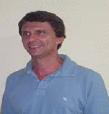
Rodrigo Gomes De Souza Vale
Employment
Ass. Prof. at the Exercise Physiology Lab of the Estácio de Sá University, Brazil.
Degree
Msc
Research interests
The physiological and morphological effects of gym physical activities and elderly physical activity.
E-mail: rodrigovale@globo.com

Estélio Henrique Martin Dantas
Employment
Full professor of Exercise Physiology at the Universidade Castelo Branco - Brasil.
Degree
PhD
Research interests
The physical fitness-related issues.
E-mail: estelio@cobrase.org.br

Ana Cristina Lopes Barreto
Employment
Assistant Professor at the Celso Lisboa University (CEUCEL), Rio de Janeiro and researcher of the Human Motricity Biosciences Laboratory of Federal University of Rio Grande do Norte (LABIMH/RN), Brazil.
Degree
MSc
Research interests
The physiological, morphological and health-related effects of gym physical activities.
E-mail: profanaclgbarreto@globo.com
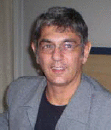
Jefferson da Silva Novaes
Employment
Professor at the Physical Education and Sport Faculty of the Federal University of Rio de Janeiro (UFRJ), Brazil.
Degree
PhD
Research interests
The physiological and morphological effects in gym physical activities.
E-mail: jsnovaes@terra.com.br
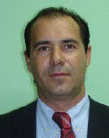
Victor M. Reis
Employment
Professor of Exercise Physiology at the Sport Sciences Department of the University of Trás-os-Montes and Alto Douro (UTAD), Portugal.
Degree
PhD
Research interests
The physiological and biomechanical indicators of energy cost during physical activities.
E-mail: vreis@utad.pt
References
- 1.Baker S.J., King N. (1991) Lactic acid recovery profiles following exhaustive arm exercise on a canoeing ergo meter. British Journal of Sports Medicine, 25(3), 165-167 [DOI] [PMC free article] [PubMed] [Google Scholar]
- 2.Baldari C., Videira M., Madeira F., Sergio J., Guidetti L. (2004) Lactate removal during recovery related to the individual anaerobic and ventilatory thresholds in soccer players. European Journal of Applied Physiology 93, 224-230 [DOI] [PubMed] [Google Scholar]
- 3.Baldari C., Videira M., Madeira F., Sergio J., Guidetti L. (2005) Blood lactate removal during recovery at varous intensities below the individual anaerobic threhsold in triathletes. Journal of Sports Medicine and Physical Fitness 45, 460-466 [PubMed] [Google Scholar]
- 4.Beaver W.L., Wasserman K., Whipp B.J. (1986) A new method for detecting anaerobic threshold by gas exchange. Journal of Applied Physiology 660, 2020-2027 [DOI] [PubMed] [Google Scholar]
- 5.Boileau R.A., Misner J.E., Dykstra G.L., Spitzer T.A. (1983) Blood lactic acid removal during treadmill and bicycle exercise at various intensities. Journal of Sports Medicine and Physical Fitness 23, 159-167 [PubMed] [Google Scholar]
- 6.Bonen A., Belcastro N.A. (1976) Comparison of self-selected recovery method on lactic acid removal rates. Medicine and Science in Sports and Exercise, 8(3), 176-178 [DOI] [PubMed] [Google Scholar]
- 7.Brooks G.A. (1986) The lactate shuttle during exercise and recovery. Medicine and Science in Sports and Exercise 18(3), 360-368 [DOI] [PubMed] [Google Scholar]
- 8.Brechat P.H., Wolf J.P., Simon-Rigaud M.L., Brechat N., Kantelip J.P., Berthelay S., Regnard J. (1999) Influence of immersion on respiratory requirements during 30-min cycling exercise. European Respiratory Journal 13, 860-866 [DOI] [PubMed] [Google Scholar]
- 9.Bulbulian R., Darabos B., Nauta S. (1987) Supine rest and lactic acid removal following maximal exercise. Journal of Sports Medicine and Physical Fitness 27(2), 151-156 [PubMed] [Google Scholar]
- 10.Chen A.A., Kenny G.P., Johnston C.E., Giesbrecht G.G. (1996) Design and evaluation of a modified underwater cycle ergometer. Canadian Journal of Applied Physiology 21(2), 134-148 [DOI] [PubMed] [Google Scholar]
- 11.Chu A.L., Jay O., White M.D. (2007) The effects of hyperthermia and hypoxia on ventilation during low intensity steady-state exercise. American Journal of Physiology - Regulatory Integrative and Comparative Physiology 292, R195-203 [DOI] [PubMed] [Google Scholar]
- 12.Connelly T.P., Sheldahl L.M., Tristani F.E., Levandoski S.G., Kalkhoff R.K., Hoffman M.D., Kalbfleisch J.H. (1990) Effect of increased central blood volume with water immersion on plasma catecholamine during exercise. Journal of Applied Physiology 69(2), 651-656 [DOI] [PubMed] [Google Scholar]
- 13.Ellestad M.H. (1993) Exercise testing in special situations. Cardiology Clinics 11(2), 241-252 [PubMed] [Google Scholar]
- 14.Ertl A.C., Bernauer E.M., Hom C.A. (1991) Plasma volume shifts with immersion at rest and two exercise intensities. Medicine and Science in Sports and Exercise 23(4), 450-457 [PubMed] [Google Scholar]
- 15.Franchini E., Takito M.Y., Nakamura W.F., Ayumi M.K., Peduti A., Molin K.M.A. (2003) Effects of recovery type after a judo combat on blood lactate removal and on performance in an intermittent anaerobic task. Journal of Sports Medicine and Physical Fitness 43(4), 424-431 [PubMed] [Google Scholar]
- 16.Frangolias D.D., Rhodes E.C. (1995) Maximal and ventilatory threshold responses to treadmill and water immersion running. Medicine and Science in Sports and Exercise 27(7), 1007-1013 [DOI] [PubMed] [Google Scholar]
- 17.Gupta S., Goswami A., Sadhukan A.K., Mathur D.N. (1996) Comparative study of lactate removal in short term massage of extremities, active recovery and a passive recovery period after supramaximal exercise sessions. International Journal of Sports Medicine 17(2),106-110 [DOI] [PubMed] [Google Scholar]
- 18.Jackson A.S., Pollock M.L. (1978) Generalized equations for predicting body density of men. British Journal of Nutrition 40, 497-504 [DOI] [PubMed] [Google Scholar]
- 19.Koutedakis Y., Sharp N.C. (1985) Lactic acid removal and heart rate frequencies during recovery after strenuous rowing exercise. British Journal of Sports Medicine 19(4), 199-202 [DOI] [PMC free article] [PubMed] [Google Scholar]
- 20.Monedero J., Donne B. (2000) Effect of recovery interventions on lactate removal and subsequent performance. International Journal of Sports Medicine 21(8), 593-597 [DOI] [PubMed] [Google Scholar]
- 21.Moore T.O., Bernauer E.M., Set G., Park Y.S., Hong S.K., Hayashi E.M. (1970) Effect of Immersion at Different Water Temperatures on Graded Exercise Performance in Man. Aerospace Medicine 41(12), 1404-1408 [PubMed] [Google Scholar]
- 22.Nakamura K., Takahashi H., Shimai S., Tanaka M. (1996) Effects of immersion in tepid bath water on recovery from fatigue after submaximal exercise in man. Ergonomics 39(2), 257-266 [DOI] [PubMed] [Google Scholar]
- 23.Nakanishi Y., Kimura T., Yokoo Y. (1999) Maximal physiological responses to deep water running at thermo neutral temperature. Journal of Physiological Anthropology 18(2), 31-35 [DOI] [PubMed] [Google Scholar]
- 24.Park K.S., Choi J.K., Park Y.S. (1999) Cardiovascular regulation during water immersion. Journal of Physiological Anthropology 18(6), 233-241 [DOI] [PubMed] [Google Scholar]
- 25.Robergs R.A., Farzenah G., Daryl P. (2004) Biochemistry of exercise-induced metabolic acidosis. American Journal of Physiology-Regulatory Integrative and Comparative Physiology 287, R502-R516 [DOI] [PubMed] [Google Scholar]
- 26.Taoutaou Z., Granier P., Mercier B., Mercier J., Ahmaidi S., Prefaut C. (1996) Lactate kinetics during passive and partially active recovery in endurance and sprint athletes. European Journal Applied Physiology and Occupational Physiology, 73(5), 465-470 [DOI] [PubMed] [Google Scholar]
- 27.Town G.P., Bradley S.S. (1991) Maximal metabolic responses of deep and shallow water running in trained runners. MMedicine and Science in Sports and Exercise 23(2), 238-241 [PubMed] [Google Scholar]
- 28.Villar R., Denadai B.S. (1998) Efeitos da corrida em pista ou do Deep Water Running na taxa de remoção do lactato sangüíneo durante a recuperação ativa após exercícios de alta intensidade. Motriz 4(2), 98-103 (In Portugal). [Google Scholar]


